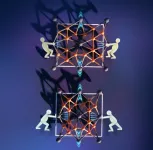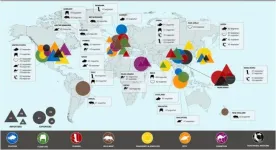The future of contactless care: robotic systems gain patient approval
2021-03-05
(Press-News.org) WHO: Giovanni Traverso, MB, BChir, PhD, Associate Physician, Division of Gastroenterology, Brigham and Women's Hospital; corresponding author of a new article published in JAMA Network Open.
Peter Chai, MD, MMS, Assistant Professor, Department of Emergency Medicine, Brigham and Women's Hospital; first author.
WHAT: In the age of COVID-19, mobile robotic telehealth systems could help clinicians and patients interact without contact. Last spring, some health care systems deployed robotic systems within a hospital to evaluate and interact with patients. In a JAMA Network Open article, Traverso and colleagues report the results of a national survey and a cohort study in an emergency department (ED), which analyzed patients' satisfaction with an initial evaluation conducted by a robotic system. Overall, 92.5 percent of patients were accepting of and satisfied with their experience.
"Taken together, this investigation suggests that a robotic system to facilitate contactless tele-triage in the ED is feasible, acceptable, and could have a large public health impact during the COVID-19 pandemic," the authors write.
In the cohort study, 40 stable patients in the Brigham's ED agreed to have their medical histories recorded by a four-legged, dog-like robotic system called Dr. Spot. The system, which includes four cameras and a mounted tablet, is operated remotely by a single emergency medicine provider. Of the participants, 92.5 percent reported satisfaction with Dr. Spot, and 82 percent stated that their experience was as good as an in-person encounter.
Results of the national survey, which was completed by 1,000 participants, indicated that individuals believe robotic systems are most useful for facilitating patient-physician interactions, acquiring contactless vital signs, and conducting basic SARS-CoV-2 testing by obtaining nasal and oral swabs. Participants also demonstrated approval of robotic systems that could support placement of intravenous catheters, and, for those who are critically ill, provide potential assistance with tasks like turning patients (proning).
"We anticipate robotic systems can be developed to assist with these tasks, especially during surges of patients with potential COVID-19 infection," the authors write. "Minimizing human contact with individuals who may have COVID-19 disease, but are otherwise well, may reduce the risk of in-hospital disease transmission and enable high-risk health care workers to safely interact with patients through tele-triage."
INFORMATION:
ELSE PRESS RELEASES FROM THIS DATE:
2021-03-05
MoS2 thin films of superposed alternating layers of molybdenum and sulfur atoms form a two-dimensional semiconducting surface. However, even a surprisingly low-intensity blue light pulse is enough to alter the properties of the surface and make it metallic. This has now been demonstrated by a team at BESSY II.
The exciting thing is that the MoS2 layers in this metallic phase are also particularly active catalytically. They can then be employed, for example, as catalysts for splitting of water into hydrogen and oxygen. As inexpensive catalysts, they could facilitate the production of hydrogen - an energy ...
2021-03-05
Approximately 15-to-30 percent of patients with metastatic breast cancer have brain metastasis (BM), with basal-like breast cancer (BLBC) metastasizing to the brain most frequently. The prognosis for BLBC-BM patients is poor, as the blood-brain barrier prevents most therapeutics from reaching the brain. Testing candidate therapies in clinical trials is also challenging because animal models that mimic BM are limited. In a new study, researchers from Brigham and Women's Hospital and collaborators engineered a bimodal tumor-suppressing and killing molecule that can be delivered to the brain by stem cells. They tested ...
2021-03-05
Beijing, 26 February 2021: the journal Cardiovascular Innovations and Applications (CVIA) has just published the third issue of Volume 5. This issue brings together important research from authors in the USA and China, including several important papers concerned with the various cardiological implications of COVID-19.
Papers in the issue are as follows.
RESEARCH PAPERS
Diyu Cui, Yimeng Liao, Jianlin Du and Yunqing Chen
A Meta-analysis of Major Complications between Traditional Pacemakers and Leadless Pacemakers
(http://ow.ly/CgYO30rz3eA)
Yue Wu, Guoyue Zhang, Rong Hu and Jianlin Du
Risk of Target Organ Damage in Patients with Masked Hypertension versus
Sustained Hypertension: A Meta-analysis (http://ow.ly/x63E30rzjEp)
Jing Li, Lijie Sun, Fang Wang, Bing Liu, Hui Li, Guodong ...
2021-03-05
If you stretch an elastic band, it becomes thinner - a physical behavior that applies to most "common" materials. Since the 20th century, an opposite behavior has been known in materials research: The so-called auxetic (from ancient Greek auxetos, meaning 'stretchable') materials expand in the direction orthogonal to the strain. Likewise, they shrink when they are compressed. Scientifically, they are characterized by a negative Poisson's ratio. Probably the best known and oldest application of unusual Poisson's ratios is the bottle cork, which has a Poisson's ratio of zero. This has the effect that the cork ...
2021-03-05
Biodiversity is declining at an unprecedented rate, due primarily to human activity. Illegal and unsustainable wildlife trade is one of the major drivers of these declines, while much wildlife trade is legal, and the quantity of trade provides the opportunity to launder illegally sourced and traded species and products.
Researchers from the Conservation Forensics Lab at HKU and Research Division for Ecology and Biodiversity, analyzed trends in global legal wildlife trade from 1997 to 2016, and revealed that legal wildlife trade averaged $220 billion per year over this period, approximately double the international trade in tea, coffee and spices, and eclipsing - by order of magnitude - annual trade in trafficked wildlife, estimated ...
2021-03-05
Less than one-third of COVID-19 clinical trials are led by women, which is half the proportion observed in non-COVID-19 trials, according to research led by Queen Mary University of London, University of St Andrews, Brigham and Women's Hospital and Harvard Medical School.
The study suggests that gender disparities during the pandemic may signify not only a lack of women's leadership in international clinical trials and new research projects, but also may expose the imbalances in women's access to research activities and funding during health emergencies.
The results of the study are being publicised to mark International Women's Day on Monday 8 March. This ...
2021-03-05
SMU Office of Research & Tech Transfer - For most of human history, populations across the world lived in low-density, rural settings. Over the past few centuries, however, this changed dramatically with the trend of urbanisation. Today, more than four billion people live in urban settings worldwide; by 2050, about two thirds of the world's population are expected to live in cities.
Despite their rapid growth, cities do not spring up fully formed, but are shaped by evolving human constructs including government policy, legal frameworks and emerging technologies. It is precisely ...
2021-03-05
Scars inside the abdomen, known as adhesions, form after inflammation or surgery. They can cause chronic pain and digestive problems, lead to infertility in women, or even have potentially life-threatening consequences such as intestinal obstruction. If adhesions develop, they must be operated on again. They also make subsequent surgical interventions more difficult. This leads to substantial suffering for those affected and is also a significant financial burden for the healthcare system. In the USA alone, adhesions in the abdomen result in healthcare costs of 2.3 billion dollars per year.
Knowledge ...
2021-03-05
Researchers from the University of Seville and Pompeu Fabra University argue that sports information on social media is dominated by men and football. This leaves out women's sports, sports featuring athletes with disabilities and minority disciplines, thus repeating the reality of the traditional media. That is the main conclusion of a study analysing more than 7,000 tweets published by the profiles of four public media in four European countries.
The study analysed the posts by the Twitter profiles providing sports news of the public broadcasters of Spain (RTVE), France (France TV), Ireland (RTÉ) and Italy (RAI). Between 30% and 58% of the tweets by these media related to football. However, differences were observed ...
2021-03-05
As the source of most of the water we drink and a place where we often go to recreate and enjoy nature, streams represent a crucial point-of-contact between human beings and the environment.
Now researchers in the College of Natural Resources and Environment and the Department of Biological Systems Engineering are using stream quality data to find new insights into the interactions between the health of our natural spaces and human well-being.
Their findings, published in the journal Ecological Indicators, reveal that demographics such as race and population density, as well as health indices such as cancer rates and food insecurity, show strong correlations with water quality across the Commonwealth of Virginia.
"We started off wanting to explore the general, intuitive ...
LAST 30 PRESS RELEASES:
[Press-News.org] The future of contactless care: robotic systems gain patient approval





